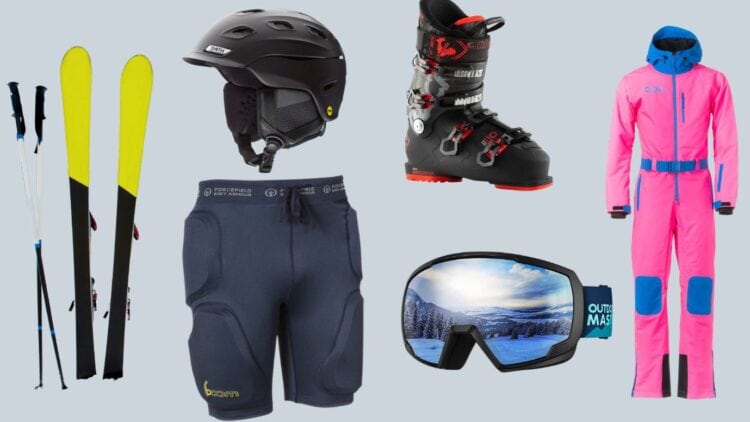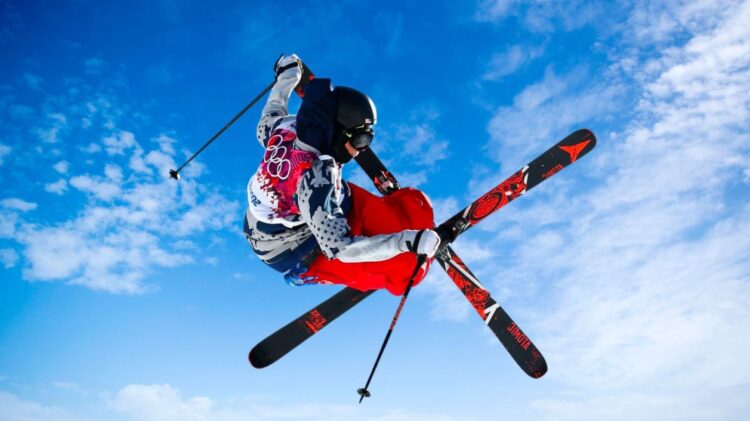
OBJECTIVE OF FREESTYLE SKIING: Score the most points by performing a variety of stunts or be the first to cross the finish line (depending on the event).
NUMBER OF PLAYERS: 1-4 players
MATERIALS: Skis, ski poles, helmet, ski suit, goggles, boots, padding
TYPE OF GAME: Sport
AUDIENCE: 7+
OVERVIEW OF FREESTYLE SKIING
Freestyle skiing is a Winter Olympic sport and skiing discipline that features several events centered around acrobatic stunts and unique skiing methods. In a way, some freestyle skiing events are more resemblant to snowboarding than skiing, with events such as cross, halfpipe, and slopestyle being prime examples.
Freestyle skiing evolved from the early acrobatic skiing of the early 1930s, which later grew into aerial skiing. In 1969, the Waterville Valley Ski Area in New Hampshire formed the world’s first freestyle skiing instructional program, resulting in the resort being considered the birthplace of the sport.
In 1979, the International Ski Federation officially recognized freestyle skiing, bringing with it a number of changes and regulations to make the sport safer. Just one year later, in 1980, the Federation hosted the first international freestyle skiing tournament.
In 1992, the moguls skiing event was officially added as an official medal event to the Winter Olympic Games, and aerials skiing followed it in 1994. Both of these events have remained in the program ever since. Six events are now involved in the freestyle skiing slate as of 2023.
SETUP

EQUIPMENT
- Skis: Ski design differs depending on the event.
- Ski Poles: Two long ski poles that help the skier accelerate, balance, and turn.
- Helmet: A basic helmet to protect the skier’s head in case of falls or collisions.
- Ski suit: A specialized ski suit that should allow for ease of movement but cannot be form-fitting.
- Goggles: To protect the skier’s eyes from snow and other hazards, as well as to help them see by reducing the sun’s glare on the snow.
- Boots: Design varies depending on the event.
- Padding: Protective pads are required to be worn on the body of skiers to help protect them from dangerous falls. Pads on other areas of the body are also recommended but aren’t mandatory.
GAMEPLAY

At the Winter Olympics, there are six distinct freestyle skiing events featured:
1. AERIAL
Top 5 Aerial Flips in Olympic Freestyle Skiing | Top Moments
A modified version of ski jumping in which skiers jump off ramps and perform a series of flips, twists, and other acrobatic maneuvers before sticking the landing to impress a panel of judges.
SCORING
A panel of five judges scores a skier’s jump based on three categories:
- Air (20%): Takes into account the skier’s jump form and the height and distance of their jump.
- Form (50%): The overall form of the skier while in the air, including their body tightness, balance, mechanics, control, and timing. This score begins at a maximum based on the skier’s planned routine, with points being deducted for breaks in their form or technique.
- Landing (30%): Judges look for a controlled and graceful landing, ideally in which the knees and lower body absorb most of the landing impact and don’t cause the hips to bend too much.
A skier’s score in each category is then multiplied by the determined degree of difficulty of their routine before being added together. The highest and lowest judge scores are dropped, and the remaining three are averaged together for the competitor’s final score. In some competitions, skiers have two jumps attempts, in which case their two jump scores are added together.
2. MOGUL SKIING
Freestyle Skiing Beijing 2022 | Men’s Moguls Final Highlights
This downhill event features skiers weaving in and out of tightly packed mounds of snow known as “moguls”.The course also consists of two ramp jumps for skiers to perform a series of mid-air stunts.
SCORING
Mogul events are scored on several factors related to technique, speed, and stunts. These include:
- Turns (60%): The technical score for how well the skier navigates the moguls/snow mounds on the course. Turns should be rhythmic and controlled yet still aggressive.
- Air (20%): This score accounts for a skier’s stunts performed mid-air during the two jumps featured in the course. A skier’s air score is based on their form and the difficulty of the stunts they perform.
- Speed (20%): A skier is also scored based on how quickly they reach the finish line.
3. SKI CROSS
⛷ Freestyle Skiing Beijing 2022 | Men’s ski cross highlights
Based on the snowboarding cross event, ski cross features heats of four competitors racing each other down a course outfitted with sharp turns, obstacles, and jumps.
SCORING
As it is a race, the objective of ski cross is to be the first one to cross the finish line. Ski cross is the only freestyle skiing event that decides a winner based solely on finishing time. Since most races feature heats of four skiers each, the top two finishers usually advance to the next round. In the final round, the final four skiers battle for the three medals.
4. BIG AIR
⛷ The best of freeski big air at #Beijing2022
Having made its inaugural appearance at the 2022 Beijing Winter Olympic Games, big air skiing follows the same principles as all other big air sports. Whether a big air event for motocross, snowboards, skateboards, or skis, the goal is to jump off a massive ramp and perform an intricate and complex stunt before sticking the landing. This is considered a high-risk, extreme sport.
SCORING
All big air events—no matter the sport—follow the same scoring criteria. Each participant’s jump is given a score ranging from 1 to 100 based on four elements of their jump:
- Difficulty: The technical difficulty of the spins, flips, and all other stunts performed during the jump.
- Execution: The control and precision of the tricks performed during the jump.
- Amplitude: The amount of height the skier reaches during their jump. Although more height is usually better, there is a certain point where too much height can result in a skier landing in the wrong spot or with bad form.
- Landing: The amount of control a skier has when landing from their jump. All tricks must be performed in the air, so the landing should always be the final element of a jump.
The skier with the highest scored jump wins the event. However, it is important to note that all big air competitions use scoring as a means to compare participants, not necessarily as an exact critique of their jump. In other words, a jump that scores a perfect 100 points wouldn’t necessarily be scored the same way in a different competition.
5. HALFPIPE
⛷ Freestyle Skiing Beijing 2022 | Women’s halfpipe final highlights
Based on the snowboarding halfpipe event, this event sees skiers gradually traverse down a U-shaped “halfpipe” while using the course’s sloped sides to perform multiple jumps and stunts throughout the run.
SCORING
Just like in big air, halfpipe events are scored from 1 to 100 based on several criteria:
- Amplitude: The magnitude of height a skier reaches and maintains throughout their run.
- Difficulty: The technical difficulty and challenge of the various stunts a skier performs throughout their run.
- Variety: The diversity of a skier’s tricks in each run is a pivotal factor in determining their final score. Judges do not want to see the same routines repeated.
- Execution: The level of control and fluidity a skier possesses when performing their stunts.
- Progression: The skier’s ability to introduce novel tricks and sequences of stunts to their routine that aren’t widely performed by other competitors.
6. SLOPESTYLE
🥇🥈 for USA in Freestyle Skiing Beijing 2022 | Men’s Slopestyle final highlights
Once again based on the snowboarding equivalent, slopestyle incorporates many elements of skateboarding, with individual skiers traversing down a course with numerous ramps, rails, and other obstacles that can be used to perform a variety of stunts.
SCORING
Slopestyle uses the same exact system of scoring as halfpipe, with a panel of judges assessing the amplitude, difficulty, variety, execution, and progression of each run.
FREESTYLE SKIING VS SNOWBOARDING
As freestyle skiing and snowboarding share four of the same events (big air, cross, halfpipe, and slopestyle), it begs the question as to what the major differences are between the two sports.
For starters, skis are generally much more beginner-friendly than snowboards, as skiing much closer resembles walking than riding sideways on a board does. However, snowboards are considered much easier to master, as controlling a single board is far less difficult than attempting to perform stunts with two skis that can end up hitting and crossing each other. For this reason alone, which also happens to be the reason why snowboards were developed in the first place, many consider snowboards to be the better of the two options for performing stunts and tricks. But with that said, this is not a universal rule, and there is no definitive rule that applies to everyone.
With all things considered, however, both freestyle skiing and snowboarding events are very similar sports.
END OF GAME
In most freestyle skiing events, the winner is the skier from the freestyle ski team who accumulates the highest score from the stunts performed during their runs. One exception is ski cross, which crowns a gold medalist based on the first skier to cross the finish line.
- 30 GAMES TO PLAY OVER TEXT - April 22, 2024
- 20+ FREE PRINTABLE BABY SHOWER GAMES - April 16, 2024
- 20+ College Party Games for the Best Night Ever! - April 2, 2024